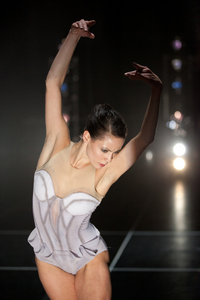Riveting dancers of the Aspen Santa Fe Ballet offer an intriguing mixed bag at Power Center

publicity photo
“Dancing,” said the great ballet choreographer George Balanchine, “is music made visible.”
Not all choreographers see it—or hear it—that way. But like it or not, it’s always a pas de deux when music and dance meet and exchange greetings on stage.
I was reminded how much that is true Sunday afternoon when I caught the second of the Aspen Santa Fe Ballet’s two performances at Power Center.
The show—three ballets in a contemporary idiom, typical of the company’s repertoire—marked the Ann Arbor debut of this well-regarded 11-dancer company directed by Tom Mossbrucker.
The company’s dancers are gorgeous things, fabulous performers: elegant of line, flexible of limb, riveting to watch. No matter what you thought of the choreography, they were a joy to watch.
The choreography, for sure, took advantage of what the dancers had to offer. And why not? Two of the pieces, “Square None” (2012) by Norbert De La Cruz II and “Over Glow” (2011) by Jorma Elo, were made for them. The third piece, Jiri Kylian’s “Stamping Ground” made in 1983 for Nederlands Dans Theater, suited them equally well. (Aspen Santa Fe has many Kylian works in its rep.) But the quirky, hyper-kinetic similarities among the pieces made them something of a blur by the show’s end.
As much as I liked De La Cruz’s “Square None,” which opened the program, it was Kylian’s ‘80s work that remains the most indelible post-performance.
Kylian took his inspiration from tribal dancing of Australian aborigines. But with or without that factoid, what you see is clear, cheeky, witty and viscerally enticing: dancing that relies on bodies making their own music; dancing that slyly evokes the animal kingdom. Pick whatever move tickled your fancy most; for me it was the woman deliciously puffing out her feathers —I mean shaking her arms and torso like a bird trying to expand its downy protective layer.
The first part of the dance unrolls in silence—“stomping” sets the rhythms in a series of solos from dancers who materialize through the silvered strands of curtain backdrop. You “see” the music—in Balanchine terms—in the dancing itself. And then, in a second half, an actual percussion score amplifies the movements: double fun, double excitement.
The dance is neatly constructed, a boon, too, in De La Cruz’s “Square None.”
What’s less apparent in De La Cruz’s work, though, is what the music and dance have to say to each other. The dance begins and ends with the electronica of Alva Noto and Ryuichi Sakamoto, Michelle Ross and Aphex Twin; Handel arias are the filling in this Dagwood sandwich. To be sure, the music colors the movement—which seems more alien and robotic in the electronic sections, more human and relational in the Handelian moments—but what the bigger message is, is hard to say. The bringing together of these disparate musical worlds, indeed, feels arbitrary and, alas, hip.
Still, the movement vocabulary—which incorporates vernacular styles and everyday gesture, baroque courtesies and ballet, angularities and suspensions—is fascinating, and De La Cruz expertly deploys his dancers across the squares marked on the floor of the downlit stage. So I found myself interested from beginning to end.
With Elo’s sextet “Over Glow,” however, I found myself restless and then distressed. The choreographer’s stance toward his musical material is at first not clear—is he with it, or agin’ it? I kept asking myself, as Mendelssohn and then Beethoven (the slow movement of the violin concerto) bubbled and swelled. What was with all the fussy, quirky, distancing, disrupt-the-flow stuff?
By the end of the Beethoven, irony, at best, seemed the attitude; when Elo sent a woman to a shuddering stage death as the big cadenza soared, all I could think about was how, for those magnificent dancers, this sublime music would forever call up kinetic memories of these unmotivated steps.

